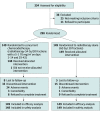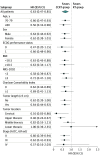Efficacy of Concurrent Chemoradiotherapy With S-1 vs Radiotherapy Alone for Older Patients With Esophageal Cancer: A Multicenter Randomized Phase 3 Clinical Trial
- PMID: 34351356
- PMCID: PMC8343504
- DOI: 10.1001/jamaoncol.2021.2705
Efficacy of Concurrent Chemoradiotherapy With S-1 vs Radiotherapy Alone for Older Patients With Esophageal Cancer: A Multicenter Randomized Phase 3 Clinical Trial
Abstract
Importance: Most older patients with esophageal cancer cannot complete the standard concurrent chemoradiotherapy (CCRT). An effective and tolerable chemoradiotherapy regimen for older patients is needed.
Objective: To evaluate the efficacy and toxic effects of CCRT with S-1 vs radiotherapy (RT) alone in older patients with esophageal cancer.
Design, setting, and participants: A randomized, open-label, phase 3 clinical trial was conducted at 23 Chinese centers between June 1, 2016, and August 31, 2018. The study enrolled 298 patients aged 70 to 85 years. Eligible participants had histologically confirmed esophageal cancer, stage IB to IVB disease based on the 6th edition of the American Joint Committee on Cancer (stage IVB: only metastasis to the supraclavicular/celiac lymph nodes) and an Eastern Cooperative Oncology Group performance status of 0 to 1. Data analysis was performed from August 1, 2020, to March 10, 2021.
Interventions: Patients were stratified according to age (<80 vs ≥80 years) and tumor length (<5 vs ≥5 cm) and randomly assigned (1:1) to receive either CCRT with S-1 or RT alone.
Main outcomes and measures: The primary end point was the 2-year overall survival rate using intention-to-treat analysis.
Results: Of the 298 patients enrolled, 180 (60.4%) were men. The median age was 77 (interquartile range, 74-79) years in the CCRT group and 77 (interquartile range, 74-80) years in the RT alone group. A total of 151 patients (50.7%) had stage III or IV disease. The CCRT group had a significantly higher complete response rate than the RT group (41.6% vs 26.8%; P = .007). Surviving patients had a median follow-up of 33.9 months (interquartile range: 28.5-38.2 months), and the CCRT group had a significantly higher 2-year overall survival rate (53.2% vs 35.8%; hazard ratio, 0.63; 95% CI, 0.47-0.85; P = .002). There were no significant differences in the incidence of grade 3 or higher toxic effects between the CCRT and RT groups except that grade 3 or higher leukopenia occurred in more patients in the CCRT group (9.5% vs 2.7%; P = .01). Treatment-related deaths were observed in 3 patients (2.0%) in the CCRT group and 4 patients (2.7%) in the RT group.
Conclusions and relevance: In this phase 3 randomized clinical trial, CCRT with S-1 was tolerable and provided significant benefits over RT alone in older patients with esophageal cancer.
Trial registration: ClinicalTrials.gov Identifier: NCT02813967.
Conflict of interest statement
Figures



Comment in
-
Primary Chemoradiotherapy for Older Patients With Esophageal Cancer.JAMA Oncol. 2021 Oct 1;7(10):1451-1452. doi: 10.1001/jamaoncol.2021.2668. JAMA Oncol. 2021. PMID: 34351378 No abstract available.
-
Definitive Chemoradiotherapy for Older Patients With Esophageal Cancer.JAMA Oncol. 2022 Feb 1;8(2):305. doi: 10.1001/jamaoncol.2021.6840. JAMA Oncol. 2022. PMID: 34967841 No abstract available.
-
Definitive Chemoradiotherapy for Older Patients With Esophageal Cancer-Reply.JAMA Oncol. 2022 Feb 1;8(2):305-306. doi: 10.1001/jamaoncol.2021.6843. JAMA Oncol. 2022. PMID: 34967851 No abstract available.
-
Definitive Chemoradiotherapy for Older Patients With Esophageal Cancer.JAMA Oncol. 2022 Feb 1;8(2):304-305. doi: 10.1001/jamaoncol.2021.6837. JAMA Oncol. 2022. PMID: 34967857 No abstract available.
-
[Profound survival benefit with concurrent chemotherapy: insights from a Chinese phase III trial in older patients with esophageal cancer].Strahlenther Onkol. 2022 May;198(5):500-502. doi: 10.1007/s00066-022-01921-6. Epub 2022 Mar 14. Strahlenther Onkol. 2022. PMID: 35286400 Free PMC article. German. No abstract available.
References
-
- National Cancer Institute. SEER cancer stat facts: esophageal cancer. Accessed January 20, 2021. https://seer.cancer.gov/statfacts/html/esoph.html
-
- Chen Y, Ye J, Zhu Z, et al. . Comparing paclitaxel plus fluorouracil versus cisplatin plus fluorouracil in chemoradiotherapy for locally advanced esophageal squamous cell cancer: a randomized, multicenter, phase III clinical trial. J Clin Oncol. 2019;37(20):1695-1703. doi:10.1200/JCO.18.02122 - DOI - PMC - PubMed

